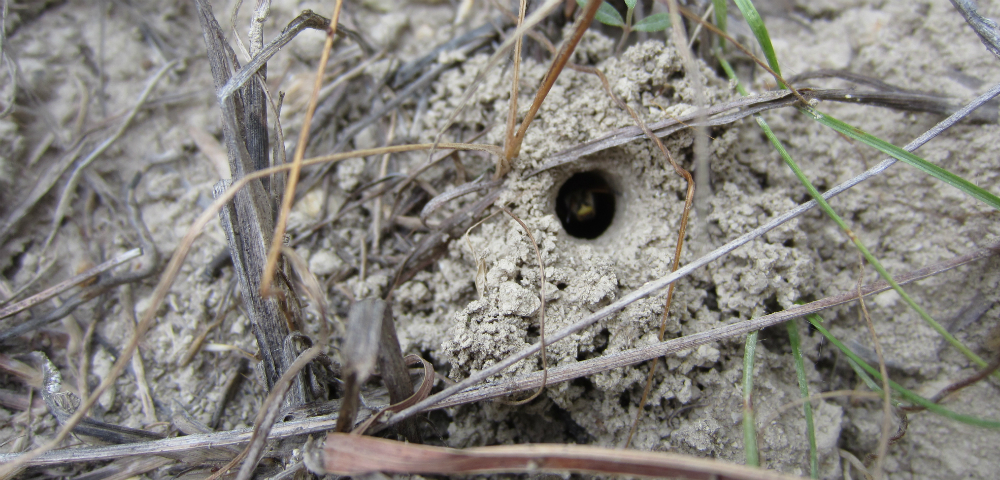Native Pollinators and Private Lands:
Social vs. Solitary Bees
Large groups of bees or wasps can inspire fear or ambivalence among many Texans. These feelings are based on the well-known defensive behaviors (biting, stinging) some social insects display when their colonies are disturbed. Despite their propensity to defend their nests, social insects will typically remain placid or even unnotice if left unmolested. Although social bees and wasps tend to garner the most attention, most bee and wasp species in Texas lead solitary lives and do not defend their nest sites. The benign nature of solitary bees and wasps makes the nests of these species safe to approach. Lack of defensive behavior at the nest also makes them a good option for those interested in promoting native bee populations in suburban/urban gardens, parks, and home landscapes. Whether social or solitary, bees and wasps perform invaluable ecological services to the state's ecosystems and agricultural production.
Social Bees and Wasps
Truly social insects live in cooperative groups composed of a queen and her daughter workers. Colonies of bald-faced hornets, European honey bees, paper wasps, and yellowjackets are well known for issuing contingents of workers to ward off perceived threats with venomous stings. Social bees and wasps are most defensive at the nest site where they have much to protect (queen, eggs, larvae, stored food). While foraging among flowers for food, social bees and wasps are often oblivious to the presence of humans or simply fly away when disturbed.
 Feral colony of the European honey bee. Courtesy of Cullen Hanks.
Feral colony of the European honey bee. Courtesy of Cullen Hanks.Social bees and wasps can be recognized by their mass aggregations and workers streaming to and from a single, defined nest site. Colonies of these species should be treated with respect. Minimize traffic, mowing, or other vibration-creating activities close to the nest. Because of their benefit to native plant communities, social bee and wasp colonies should be conserved unless they cause direct damage by their nesting activity or constitute a stinging threat. If a colony of social bees or wasps must be exterminated it is advisable to use the services of a licensed pest control operator. Some honey bee-keepers will provide removal services for this insect. For more information on honey bee removal see Texas Apiary Inspection Service: Bee Removal.
Only a very small number of native bees in Texas are social. The largest and most familiar are bumble bees. Their black and yellow bodies are easy to recognize as they buzz from flower to flower. Nine bumble bee species have been recorded from Texas. Bumble bee diversity is greatest in eastern Texas and declines westward across the state. While bee diversity overall tends to peak in arid regions, bumble bees in North America increase in diversity at higher latitudes and elevation.
Solitary Bees
Approximately 90% of bees native to Texas are solitary species. Unlike social bees, solitary bee females establish and provision nests on their own with no assistance from other individuals. There is no division of labor into queens, workers, or drones. Because nests are established by lone females, these bees will not attempt to defend their nest sites through aerial sting attacks. If a female solitary bee dies, then she could lose her entire reproductive effort as there is no colony to provision her young in her absence. Male bees do not collect pollen to provision young or otherwise assist in raising offspring.
 Native solitary bee. Courtesy of Jessica Womack.
Native solitary bee. Courtesy of Jessica Womack.Even though they do possess stingers, female solitary bees tend to flee or hide when disturbed at the nest. The nest sites of native solitary bees can be approached without fear of defensive attack. Make sure you know the difference between social and solitary bee species in your area, though, to ensure your safety. Always first observe nests of bees and wasps from some distance in the case they may be a social species. Stings from native solitary bees typically only occur if an individual bee is trapped in clothing or grasped by hand. Artificial nest structures for these bees can be placed next to areas of human activity.
The majority of solitary bees are ground-nesters that excavate burrows in well-drained, sunny patches of bare-ground. Ground-nesting species may occur in large aggregations noticeable through the presence of dozens of small holes surrounded by mounded piles of dirt. The remaining contingent of solitary bees nests in existing cavities in dead wood (generally galleries left by wood-boring beetle larvae) or chew their own cavities into woody material. There are even a few solitary bees that nest in discarded snail shells and dried cow dung.
 Native ground-nesting solitary bee in nest. Courtesy of Michael Warriner.
Native ground-nesting solitary bee in nest. Courtesy of Michael Warriner.During the spring and summer months, female solitary bees provision nests with food (lumps of pollen mixed with nectar and saliva), lay eggs, tightly sealing the nest upon completion. Females may establish multiple nests over their adult lives that may span several weeks up to a few months. After a nest is completed, females move on to the next nesting opportunity never to revisit or safeguard their previous work. Their eggs and the resulting larvae feed on the stored food, overwinter inside the nest, and emerge the following year as adults to begin the cycle again.
Solitary bees tend to be less frequently observed than their social relatives. They may even be hard to identify as a "bee" given their wide range of shapes, sizes, and color patterns. Less well-known solitary bees such as large carpenter bees, leaf-cutter bees, mason bees, mining bees, squash bees, sunflower bees, and sweat bees are responsible for a substantial amount of pollination in agricultural and ecological systems. Learn about the major groups of bees at BugGuide: Bees. For help identifying bees you observe, join and report your observations to the Nongame and Rare Species Program's Bees and Wasps of Texas (iNaturalist) project.